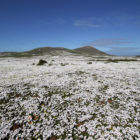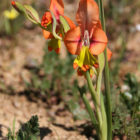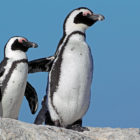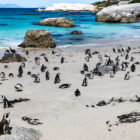Dates & Prices |
BOOK NOW |
Dates: 29th August – 10th September 2025 Confirmed departure
Price: £4,095 Places available
Single Room Supplement: £395
Deposit: £400 per person
Price Includes: All meals, accommodation with private facilities, ground transport, services of the guides, holiday report
Not Included: Flights, travel insurance, drinks and any other personal items
Conservation Donation: 10% of profits donated to charity
Leaders: Frank Gaude (plus second guide for larger group)
Languages: Guiding in English and German
Group Size: Minimum of 4 and a maximum of 9 guests plus 1-2 leaders
Holiday Highlights
- Visit the Cape Floral Kingdom, a veritable flower feast and an unrivalled area with the highest concentration of plant species anywhere, most of which are endemic!
- A relaxed tour, with plenty of time to photograph and appreciate the flora and fauna of the area
- Breath-taking scenery of the Cape!
- Visits to Kirschenbock Botanical Gardens, Hantam botanic gardens, Table Mountain, West Coast and other National Parks
- We will explore a wide range of habitats, particularly Mediterranean Fynbos, Namaqualand, Wild Coast, and the Cederberg mountains
- Travel altogether in one vehicle, an air-conditioned minibus (Toyota Quantum, 14-seater), with Most days on made up roads & minimal time on gravel
- Endemic spring bulbs, Proteas, Ericas, Restios, Pelargoniums & orchids
- Peninsula tour with African Penguins in abundance at Boulder Beach
- Birds such as Sunbirds, White-eye Spurfowl, Warblers, Flycatchers
- Reptiles such as Angulate Tortoise, Black Girdled Lizard and Southern Rock Agama
- Mammals, including Chacma Baboon, Bontebok, Eland Antilope, Grey Rhebok, Klipspringer, Cape Mountain Zebra, Red Hartebeest and Steenbok
After rainy winters, the South African spring transforms the otherwise barren and hostile semi-desert of western South Africa into a vibrant, colourful landscape. We will travel through different habitats of savanna, thicket, grasslands, fynbos and desert. To travel through the changing landscape is to travel through several worlds in one subcontinent. Above all, bulbous plants, which belong to the families of the iris and hyacinth family, are numerous, but also orchids, pelargonium and many species that have adapted by their succulent form of growth to the climatic conditions. Will visit the Cederberg mountain about 200 km north of Cape Town, known as a hiking and climbing paradise. A 50,000 hectare area of this mountain range enjoys the status of a nature reserve. The bizarre landscape of the southern Cederberg houses a variety of native plants, which are not flower carpets, but often very beautiful and photogenic. Likewise Nieuwoudtville, where we will be based for 3 nights has an extremely high biodiversity in the plant world, especially with regard to bulbous plants such as iris, hyacinths and amaryllis. Langebaan, our two-night stop, is located on a large lagoon in the West Coast National Park, known for its abundance of flowers, which often cover large areas of the park. On our itinerary is also the Kogelberg Nature Reserve, comprising the Kogelberg Mountain Range, to the east of Cape Town, South Africa. With about 1,600 plant species, it contains a floral diversity per unit area that is greater than anywhere else in the world. We shall also spend some time in the world famous Kirstenbosch Botanical Gardens, an excellent place to observe birds too. We shall go to see the African Penguins and during our travels we shall take in other birds, mammals and reptiles that come our way. Weather: We can expect temperatures between 0 and 30 degrees in Nieuwoudtville and Clanwilliam. Mostly it is not that extreme, but it’s important to be prepared for a wide range of temperatures, best done with several layers that can be added/removed during the course of the day. Since it is the end of the rainy season we also have to be prepared for some rain. Therefore waterproof/resistant clothing will come in handy should we experience rainfall. Passport requirements: To enter South Africa, a passport valid for at least 30 days after the intended date of departure is required. Passports must have at least two blank pages for entry stamps. EU citizens get their 3-month tourist visa when entering the country. Health and fitness: We won’t undertake major hikes and there will be virtually no inclines, so anyone with ‘normal fitness’ is able to participate. Walks will happen on natural, sometimes uneven ground, over rocky, sandy and gravelly terrain, so sturdy shoes with good adhesion are required. Hiking boots with ankle support for uneven ground are ideal. Languages: The guides are native and/or fluent speakers in English and German. This promises to be a fantastic and very popular tour – we recommend booking early to avoid disappointment!




Day 0 (28th Aug): International overnight flights, e.g. from the UK.
Day 1 (29th Aug): Arrival and transfer to our accommodation in Cape Town. Depending on time of arrival we may have a walk in a suitable area
Day 2: Cape Town – Langebaan
We drive from Cape Town along the West Coast towards Langebaan, ca 120 km north of Cape Town. Our first stop is at Bloubergstrand, where a seemingly endless sandy beach with panoramic views of Table Mountain invites you to take a stroll on the beach and where we may make our first floral finds in the coastal dunes.
A little detour from the coastal route will take us to the little town Darling, where we look for interesting plants in some of the remaining patches of Renosterveld around town.
We expect a multitude of bulbs from the Iris family, such as Babiana, Gladiolus, Geisshorhiza, Ixia and Wurmbea as well as the abundant Zantedeschia aethiopica. Several endemics to be ticked. We continue with our tour to Langebaan, where we will spend the next two nights.
Day 3: West Coast National Park
The whole day is available for exploring the West Coast National Park. A short hike of about 3 km will be an optional part of today’s program, where we will see many bulbs and annual plants in flower. We will visit the separate ‘Postberg’ section of the National Park. Closed for most of the year, it opens in August and September when the flowers are at their best. We expect to see carpets of flowers in vibrant colours. Angulate Tortoises, birds, a variety of Antilopes such Bontebok, Eland, Steenbok, Cape Mountain Zebra and a passing whale are possible.
Day 4: Langebaan – Nieuwoudtville
Today we cover a longer stretch on the road of about 330 km with many interesting stops on the way. From Langebaan we continue on the coastal road past the town of Velddrif, where we may see Greater and Lesser Flamingos, Stilts, Avocets and others in the surrounding salt pans. North of Velddrif will put in a stop to explore the coastal dunes rich in bulbs and other interesting plant life such as Euphorbia caput-medusae.
At ‘Bird Island’, at the harbour of the fishing village Lambert’s Bay, we can observe thousands of Cape Gannets and different Cormorant species. From Lamberts Bay we drive inlands and drive for about two hours over the Vanrhyns Pass to Nieoudtville, where we will spend the next three nights.
Day 5: Nieuwoudtville
We visit several Flower Reserves where we will see loads of bulbs. The area around Nieuwoudtville is known as ‘Bulb Capital of the World’. We expect to see Ornithogalums, Romuleas, Moraeas, Babianas, Sparaxis, Gladiolus, Ixias, Lachenalias and Bulbinella, for which South Africa is the world centre of evolution.
In the afternoon we visit the nearby Waterfall and the Quiver Tree Forest. The kokerboom in Afrikaans, quiver tree in English, belongs to the group of plants known collectively as aloes. Both the Afrikaans and the English names are derived from the San people’s practice of making quivers from the branches of the trees.
Day 6: Nieuwoudtville
Today we visit private and public nature reserves to complete the impression of the diverse flora. This includes the Hantam Botanical Gardens. These are not botanical gardens in the classical sense with attached beds, but a particularly valuable protected area where above all the rare type of vegetation ‘Renosterveld’ with its incredible biodiversity is protected.
Day 7: Nieuwoudtville – Clanwilliam
We drive back down the Vanrhyns Pass and before we continue on our way to Clanwilliam we take some time to explore a small patch of the Knersvlakte, a part of the succulent Karoo characterized by Dwarf Succulents growing amongst Quartz pebbles. We aim to find the local species of Agyroderma and Conophytum and interesting bulbous plants that have adapted to this extreme environment.
After a lunch stop, we continue our trip and will take another detour to the Gifberg, a flat-topped mountain towering the surrounding Knersvlakte. We will drive up to explore some of its interesting flora, featuring bulbs such as Babiana, Lachenalia and Gladioli, succulents such as Crassula alpestris and some tiny Orchids of the genera Holothrix, Pterygodium and Satyrium.
We continue to Clanwilliam at the foot of the Cederberg range, where we will spend the next two nights.
Day 8: Northern Cederberg.
From Clanwilliam we will make excursions in the vicinity, where we have the opportunity to admire wildflowers and fascinating rock formations as well as the rock paintings of the Khoisan on short hikes. Of the Khoisan, the original population of this region, is now little known. Only their ancient rock paintings have survived the time. On the Sevilla Rock Art Trail, we will admire both the rock paintings of the San and the regional spring flowers.
Around the Pakhuis Pass we will keep our eyes peeled for Protea, bulbs and Pelargonium species.
If we have time to spare, we will descent into the Biedouw Valley, known for its richness in bulbs such as the endemic Cyanella alba flavescens and succulents such as Hoodia gordonii.
Day 9: Clanwilliam – Cape Town
After breakfast we say goodbye to the Cederberg and drive to Cape Town (ca 3 hours).
After our arrival at our guest house we will spend the afternoon in Cape Town’s Kirstenbosch National Botanical Garden, regarded as one of the great botanical gardens of the world. Situated on the slopes of Table Mountain, just 13km from the city centre, Kirstenbosch includes a fragrance garden, a medicinal garden, a Protea garden, a braille trail, and a cycad amphitheatre. There is also the Botanical Society Conservatory, which houses plants from the continent’s more arid regions. There is a book shop and gift shop in the gardens. Birding at Kirstenbosch is excellent.
Day 10: Table Mountain
We visit famous Table Mountain by Cable Car and explore the flora on top. We may see many of the plants indigenous to Table Mountain, first and foremost Proteas and Ericas.
Some birding is possible, with Orange-breasted Sunbirds, Karoo Prinias and Rock Kestrels present and Red-winged Starlings in abundance.
Commonly seen reptiles include Black Girdled Lizard, Cape Crag Lizard and Southern Rock Agama.
A likely mammal to look for will be the Rock Hyrax.
The views from Table Mountain are magnificent, of course.
After our visit to Table Mountain we may have sufficient time for birding and botanizing in smaller protected areas in the greater Cape Town area.
Day 11: Peninsula Tour
This day will be used to explore the scenic Southern tip of the Cape Peninsula. We will, of course, pay a visit to the African Penguins at Boulders Beach near Simon’s Town, where we will not only see the Penguins in abundance, but also Sea Gulls, Cormorants and Rock Hyraxes. At the Cape of Good Hope Nature Reserve, we will focus on flora and fauna, but of course there will be opportunity for the obligatory photograph at the signboard ‘Cape of Good Hope’.
Possible mammal sightings include the Chacma Baboon, Bontebok, Eland Antilope, Grey Rhebok, Klipspringer, Cape Mountain Zebra, Red Hartebeest and Steenbok.
Likely birds to be encountered are Cape Sugarbird, various sunbirds, Ostriches, Cormorants, Terns and Black Oystercatcher, amongst many others.
Likely reptiles to be encountered are Angulate Tortoise, Black Girdled Lizard and Southern Rock Agama.
Plant diversity is fantastic with about 1200 species of the Fynbos biome, some of which are endemic to this area. Proteas, Ericas, Restios, Pelargoniums and many bulbs are there to be found and photographed, some on easy hiking trails, others from the road travelled by car.
Day 12: Kogelberg Nature Reserve
From Cape Town we will travel further to the Kogelberg Nature Reserve, a protected area known to be a biodiversity hotspot. In this World heritage site, we will go on a short walk of about 2 hours to have a closer look at the varied local Fynbos flora.
Day 13 (10th Sept): Departure. We drive to the airport for onward travel, including those for a return flight back to London. Will make suitable stops on the way.
Notes. We will try to take our time at each location. If we find that we need to spend more time at any location due to peoples interest we might have to alter the itinerary.
New holiday – testimonials will appear next year
New holiday – report will follow later












































